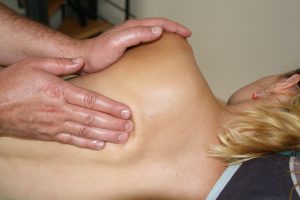The most common question that might arise after reading the title would be how these two different massage types differ from each other, the kind of relaxation they give, and the benefits each type of massage holds.
Swedish Massage vs. Deep Tissue Massage
Both Swedish massage and deep tissue massage are highly beneficial for anyone who wants the kind of relaxation these massage therapies have to bring, but they do have some key differences.
You need to understand these before you can schedule your appointment at a spa or private practice! After all, you want the best treatment for your day off, so let’s break it down for you!
Deep Tissue Massage

Deep tissue is a popular massage therapy modality that involves the application of firm pressure and slower strokes to reach the deeper layers of the muscle.
It is mainly done by many if they’re suffering from chronic aches and pain, such as a stiff neck, upper back, low back pain, leg muscle tightness, and sore shoulders.
Deep Tissue Massage Benefits
Deep tissue massage usually caters to a specific problem, such as chronic muscle pain, injury rehabilitation, and the following conditions listed below:
- Limited Mobility
- Postural Problems
- Lower Back Pain
- Upper back or Neck Pain
- Fibromyalgia (This particular disorder includes musculoskeletal pain throughout the body. If not treated, it can affect your brain)
- Repetitive strain injury (This is caused due to increased screen time, mainly people who have desks jobs complain about this specific issue)
These are just some of the conditions that can be solved if you opt for deep tissue treatment. In many cases, sports athletes opt for this massage as it treats sports injuries, so do try it or recommend it to a friend who has sore muscles from overtraining.
Most importantly, if you’re generally an active person and are not tied to your desk all day, then this massage is a perfect solution for bulletproof health, so why don’t you rush to your local massage therapist?
What To Expect In Your Appointment?
Deep tissue massage methods are utilized to break up scar tissue and muscle adhesions that can restrict blood flow, limit movement, and cause pain.
Toward the start of deep tissue work, lighter pressure is gently applied to warm up get the muscles. A combination of the following strategies is then applied.
Stripping: Deep moving pressure is applied along the length of the muscle strands utilizing the elbow, lower arm, knuckles, and thumbs.
Friction: Pressure is applied over the tip of the muscle to realign tissue filaments.
Make sure to tell your massage therapist where you’re feeling your pain, so you can get the most out of the session.
A quick tip is to drink water after the massage, as some clients feel dehydrated after a session. In any case, contact a Certified Massage Therapist in Sterling VA to have a wholesome experience!
Swedish Massage

Swedish massage therapy is the standard type of massage that is commonly offered in most clinics, gyms, and spas.
Therapists begin using lotion or oil and apply gentle and soft strokes to increase overall circulation and warm up the muscle tissues.
There are five common stroke types in Swedish massage therapy:
- Effleurage (long smooth strokes)
- Petrissage (rolling and lifting
- Friction (small circular movements)
- Tapotement (percussion)
- Vibration (shaking movements)
Swedish massage significantly increases oxygen flow in the blood and offers incredibly stress-relieving properties.
That said, Swedish massage is ideally suited for most people who just want to relax, unwind, and boost their overall health.
Swedish Massage Benefits
Swedish massage is an all-time favorite choice for spa-goers! The benefits include:
- Relaxes the nervous system
- Speeds up the healing process for injuries and illnesses
- Decreases muscle fatigue
- Loosens joints and improves range of motion
- Improves lymphatic drainage
- Stimulates blood circulation
- Promotes better muscle and skin tone
- Loosens tight muscles
- Stretches connective tissue
What to Expect
In Swedish massage, the client lies on a massage table and is draped with either a towel or sheet. It is usually a full-body massage treatment, and not injury-specific unless the client specifies otherwise.
Each session usually lasts for about an hour. Essential oils, massage gels, lotion, or unscented oil are used during the treatment!
Certified massage therapists undergo extensive training, so you can feel rest assured you’re literally in good hands.
When selecting the right massage therapist for a chronic pain condition, it’s best to select a medical massage therapist or one that has orthopedic massage training.
Conclusion
So now that you know a lot more about how these two massage modalities, you can decide which one is best for you. Remember to consider all the points mentioned above when booking an appointment.
Lastly, you might get excited about opting for cheaper deals, but you’re more likely to be disappointed as the therapists that are employed tend to have less training. However, there are always exceptions, so just make sure to read reviews.

